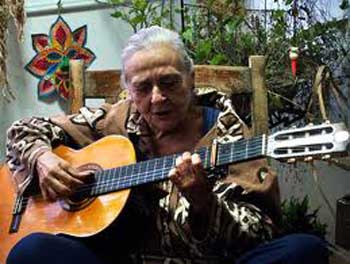Teresita Fernandez: A Singular Cuban Troubadour
Musical Bridge from Cuba*
Osmel Almaguer

HAVANA TIMES, April 1 — The “mother of Cuban children’s music,” Teresita Fernandez has created extremely popular children’s songs like “Dame la mano y danzaremos,” “El gatico vinagrito,” and “Tin, tin, la lluvia cayo.”
In fact more than three generations of Cubans have grown up listening to such compositions and interpretations by her.
Among her best known songs that have set poems to music are “Ismaelillo,” originally by Jose Marti, and the serenades of “Gabriela Mistral.” In these, like with those written by her own hand, love and education come overflowing for Cuban children and the world at large.
She is a non-stop troubadour, as she calls herself, and an educator who possesses a doctorate degree in education.
Her work is both beautiful and extensive, as she takes it all over the country; indeed she does not limit herself to composing and performing songs, but she has also founded several peñas (regular music circles).
Internationally, she has been involved in the “Jornada Dariana” in Nicaragua and the “2nd Latin American Festival of Oral and Dramatic Narrative” in Monterrey, Mexico, where she won the Chaman Prize.
Her lifelong work was crowned with a series of popular and institutional honors. Among the most recent distinctions are “Por la Educacion Cubana,” “Por la Cultura Nacional,” “Raul Gomez Garcia,” “Trescientos Aniversario de la Fundacion de Santa Clara,” the “Los Zapaticos de Rosa” Prize and “Rafael Maria de Mendive.
Lo feo (The ugly one)
In an old washbowl / I grew violets for you / and being near the river / from an empty snail shell
I picked out a star for you.
In a broken bottle / I kept a firefly for you / and on a dull fence / I placed some coral / that flowered for you.
Garbage man, garbage man / who nobody wants to look at / But if the moon rises / your cans are going to shine.
Alita the cockroach / is carried to the ants nest / as I wish to be in my death / with them taking me to the cemetery.
To the things that are ugly / give them a little love / and how see the sadness / changes its color.

The is a message expressed so clearly that it’s difficult not to be understood, despite the many cultural barriers that occasionally exist between the author and the reader (or audience).
It is a song — perhaps like “Momo,” that novel by the German writer Michael Ende — that has transcended its primary purpose (to convey a positive message to children) to be appreciated by adult audiences (to cite only two examples: Teresita herself or the duo Gema y Pavel).
It is in a certain area of ??the work of its artists where the Cuban Revolution has reaped what in my opinion is the most authentically humanist product, and we could include this song within that legacy.
Her sensitive, deep, altruistic and positive spirit is a good way of speaking to the younger generation, so lacking in the values that are championed in this song.
—–
(*) A Musical Bridge from Cuba: This is an effort to find new bridges that promote communication between peoples of the diverse regions of the planet. I will be using simple narration in a series of articles to connect with those who are interested in the messages transmitted by Cuban songs, which due to their limited commercial potential and the difficulties posed by their translation, languish in a state of communicational stagnation – despite their being true jewels of Cuban culture.





